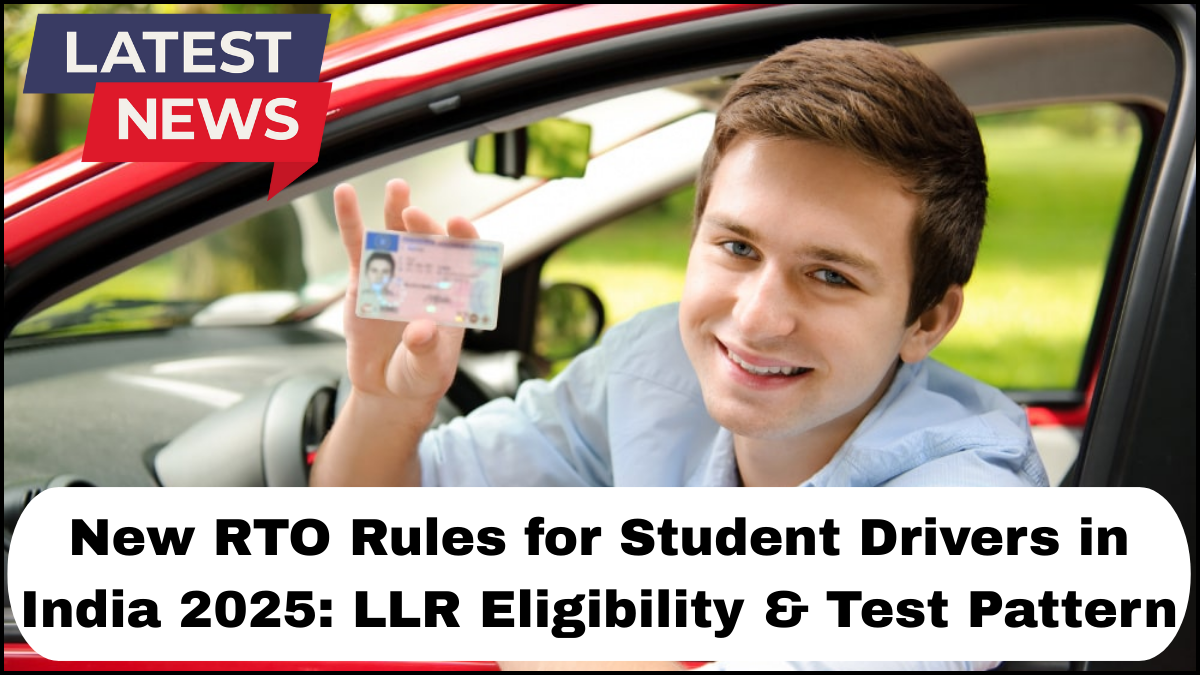The New RTO Rules for Student Drivers in 2025 mark a significant shift in how learner’s licenses (LLRs) are issued and how aspiring drivers, especially students, are trained and tested in India. The Ministry of Road Transport and Highways (MoRTH) has introduced these updates to promote road safety, standardize driving education, and make the licensing process more transparent and rigorous. This guide breaks down the latest changes, eligibility criteria, test formats, and what student drivers need to know before applying.

Why the Rules Have Changed in 2025
The rise in road accidents involving young and inexperienced drivers has prompted stricter regulations. The new rules are designed not just to control the number of untrained drivers on the roads, but to equip student drivers with the right skills, knowledge, and awareness before they get behind the wheel. These rules also align with India’s long-term goals under the National Road Safety Policy.
Updated LLR Eligibility Criteria for Students
Under the New RTO Rules for Student Drivers in 2025, the eligibility criteria for obtaining a learner’s license have become more structured:
-
Minimum Age Requirement:
-
Two-wheeler (without gear): 16 years, with parental or guardian consent.
-
Two-wheeler (with gear) or light motor vehicle: 18 years.
-
Commercial vehicle: 20 years (no change).
-
-
Educational Qualification:
While not mandatory nationwide, some states are now recommending a minimum Class 8 pass certificate for student drivers to ensure basic literacy in reading road signs and instructions. -
Parental Authorization for Minors:
Applicants under 18 must submit a duly signed consent form from a parent or guardian, accompanied by valid ID proof. -
Aadhar-Based Verification:
The use of Aadhar is now mandatory for identity authentication, reducing documentation errors and fraudulent applications. -
Mandatory Enrolment in Registered Driving Schools:
Students applying for an LLR must complete a minimum 10-hour training module from a state-authorized driving school. This includes both theory and practical orientation.
Revised LLR Test Pattern for 2025
The learner’s license test is now more comprehensive, focusing on both knowledge and judgment. Here’s what student drivers can expect:
1. Computer-Based Test (CBT)
-
Duration: 30 minutes
-
Format: Multiple choice questions (MCQs)
-
Number of Questions: 20
-
Passing Score: 16 correct answers
-
Subjects Covered:
-
Road signs and markings
-
Traffic rules and penalties
-
Defensive driving techniques
-
Vehicle maintenance basics
-
Emergency response on roads
-
2. Situational Awareness Scenarios
In some states, an additional module tests the driver’s decision-making ability. These are simulated driving situations where the applicant chooses the safest course of action.
3. Language Accessibility
To remove regional barriers, tests are now offered in 12+ Indian languages including Hindi, English, Tamil, Bengali, and Kannada.
Stricter Verification & Test Integrity Measures
The system now employs AI-based monitoring tools in test centers to prevent impersonation or cheating. Students must undergo live webcam verification before starting their online or in-center exam.
What the Student Driving License Guide Now Emphasizes
As part of the broader student driving license guide, students are encouraged to focus not only on clearing the LLR but also on responsible driving practices. Key additions include:
-
Compulsory Traffic Safety Workshops before taking the driving test.
-
Road Behavior Certification, issued after completion of a traffic discipline session.
-
Introduction of e-learning portals where students can revise traffic rules interactively.
Penalties for False Information or Proxy Appearances
Any applicant found using forged documents, proxies, or false information will face:
-
Immediate cancellation of application
-
Suspension of eligibility for 6 to 12 months
-
Legal action under the Motor Vehicles Act, 1988
Impact on Student Drivers and Guardians
These new RTO guidelines are not meant to create barriers, but to ensure that every student driver earns their license through merit and responsibility. Parents and guardians play a crucial role in mentoring student drivers and helping them navigate these updated procedures.
FAQs on New RTO Rules for Student Drivers 2025
Q1: Can a 16-year-old student ride a gearless scooter under the new rules?
Yes, with parental consent and after passing the LLR test, a 16-year-old can ride a gearless scooter with an engine capacity of up to 50cc.
Q2: Is it compulsory to attend a driving school for the LLR?
Yes, under the 2025 rules, attending a certified driving school is mandatory before appearing for the LLR test.
Q3: Can I take the LLR test from home?
Some states offer online LLR testing with webcam-based proctoring. However, first-time applicants are generally advised to appear at an RTO or affiliated testing center.
Q4: What happens if I fail the LLR test?
You can reattempt the test after 7 days. You’ll need to pay a nominal retest fee.
Q5: Are these rules applicable nationwide?
Yes, though implementation details may vary slightly from state to state. Always check with your local RTO for region-specific updates.
click here to learn more